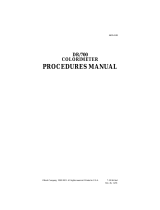Page is loading ...

COMPONENTS:
1 x 4029 Pipet, Calibrated (0.5 & 1.0 mL), plastic
2 x 4030 Pipet, Calibrated (0.5 & 1.0 mL) w/ cap, plastic
1 x 4078 Pipet, Graduated (3 mL w/ 0.5 mL div), plastic
1 x 5359 Instruction
3 x 9198 Sample Tube, Graduated (25 mL) w/ cap, plastic
1 x R-0890-C Molybdenum Buffer Solution, 2 oz
1 x R-0892-C Molybdenum Titrating Solution, 2 oz, DB
1 x R-0900-I Molybdenum Indicator Powder, 10 g
1 x R-0901-C Molybdenum Indicator Solvent, 2 oz
TO ORDER REPLACEMENT PARTS AND REAGENTS CALL TOLL-FREE
800-TEST KIT (800-837-8548).
PROCEDURE:
CAREFULLY READ AND FOLLOW PRECAUTIONS ON REAGENT LABELS.
KEEP REAGENTS AWAY FROM CHILDREN.
NOTE: When dispensing reagents from dropper bottles, always hold bottle in a
vertical position.
Molybdenum Test
Molybdenum Indicator Solution Preparation:
For 1 drop = 2, 20, or 50 ppm Molybdenum
Using a 1.0 mL pipet (#4030), add 2.5 mL R-0901 Molydenum Indicator Solvent
to a clean 25 mL sample tube (#9198). Add 5 level dippers R-0900 Molybdenum
Indicator Powder. Swirl until solution turns a clear, reddish-orange color.
Undissolved crystals will remain in the solvent-powder mixture (Fig. 1).
DROP TEST
MOLYBDENUM (1 drop = 2, 5, 20 or 50 ppm)
For 1 drop = 5 ppm Molybdenum
Using a 1.0 mL pipet (#4030), add 1.5 mL R-0901 Molydenum Indicator Solvent
to a clean 25 mL sample tube (#9198). Add 3 level dippers R-0900 Molybdenum
Indicator Powder. Swirl until solution turns a clear, reddish-orange color.
Undissovled crystals will remain in the solvent-powder mixture (Fig. 1).
For 1 drop = 2 ppm Molybdenum
1.Rinseandllaclean25mLsampletube(#9198)to25mLmarkwithdistilled,
deionized,ormolybdenum-freetapwater.Thiswillbetheblank.
2.Rinseandllasecondclean25mLsampletubeto25mLmarkwithwatertobe
tested (Fig. 2).
3. Using a 1.0 mL pipet (#4030), add 1.0 mL R-0890 Molybdenum Buffer Solution
to each 25 mL sample tube. Swirl to mix.
4. Using a separate 1.0 mL pipet (#4029), add 1.0 mL Molybdenum Indicator
Solution (prepared above) to each sample tube, transferring as few undissolved
crystals as possible. However, a few crystals that may be transferred will not
affectresults.Swirltomix.Theblankwillturnpeach(Fig.3)andthesamplewill
turn reddish orange to red (Fig. 4) if molybdenum is present.
5. Add R-0892 Molybdenum Titrating Solution, dropwise, swirling and counting after
each drop, to sample tube containing water sample, until sample color matches
blankcolor,oruntilnofurtherchangeincoloroccurs.
6. Multiply drops of R-0892 Molybdenum Titrating Solution by 2. Record as parts per
million (ppm) molybdenum.
NOTE: To convert molybdenum (Mo) readings to molybdate (MoO
4
), multiply
Mo readings by 1.7; to convert to sodium molybdate dihydrate
(Na
2
MoO
4
•
2H
2
O), multiply by 2.52.
Fig. 1
Fig. 2
Fig. 3
Instr. #5359
(OVER)

NOTE: For1drop=20ppm,llpipetto2.5mLmark.
For1drop=50ppm,llpipetto1.0mLmark.
3.
Dilute to 25 mL mark with distilled, deionized, or molybdenum-free tap water
(Fig. 2).
4. Using a 1.0 mL pipet (#4030), add 1.0 mL R-0890 Molybdenum Buffer Solution
to each 25 mL sample tube. Swirl to mix.
5. Using a separate 1.0 mL pipet (#4029), add 1.0 mL Molybdenum Indicator
Solution (prepared above) to each sample tube, transferring as few undissolved
crystals as possible. However, a few crystals that may be transferred will not
affectresults.Swirltomix.Theblankwillturnpeach(Fig.3)andthesamplewill
turn reddish orange to red (Fig. 4) if molybdenum is present.
6. Add R-0892 Molybdenum Titrating Solution dropwise, swirling and counting after
each drop, to sample tube containing water sample until sample color matches
blankcolororuntilnofurtherchangeincoloroccurs.
7. For 2.5 mL sample, multiply drops of R-0892 Molybdenum Titrating Solution by
20. Record as parts per million (ppm) molybdenum.
For 1.0 mL sample, multiply drops of R-0892 Molybdenum Titrating Solution by
50. Record as ppm molybdenum.
NOTE: To convert molybdenum (Mo) readings to molybdate (MoO
4
), multiply
Mo readings by 1.7; to convert to sodium molybdate dihydrate
(Na
2
MoO
4
•
2H
2
O), multiply by 2.52.
DROP TEST
MOLYBDENUM (1 drop = 2, 5, 20 or 50 ppm)
Instr. #5359
31LovetonCircle,Sparks,MD21152U.S.A.
800-TEST KIT (837-8548) • 410-472-4340 8/16
For 1 drop = 5 ppm Mo
1.Rinseandllaclean25mLsampletube(#9198)to10mLmarkwithdistilled,
deionized,ormolybdenum-freetapwater.Thiswillbetheblank.
2.Rinseandllasecondclean25mLsampletubeto10mLmarkwithwaterto
be tested (Fig. 2).
3. Using a 1.0 mL pipet (#4030), add 0.5 mL R-0890 Molybdenum Buffer Solution
to each 25 mL sample tube. Swirl to mix.
4. Using a separate 1.0 mL pipet (#4029), add 0.5 mL Molybdenum Indicator
Solution (prepared above) to each sample tube, transferring as few undissolved
crystals as possible. However, a few crystals that may be transferred will not
affectresults.Swirltomix.Theblankwillturnpeach(Fig.3)andthesamplewill
turn reddish orange to red (Fig. 4) if molybdenum is present.
5. Add R-0892 Molybdenum Titrating Solution, dropwise, swirling and counting after
each drop, to sample tube containing water sample until sample color matches
blankcolororuntilnofurtherchangeincoloroccurs.
6. Multiply drops of R-0892 Molybdenum Titrating Solution by 5. Record as parts per
million (ppm) molybdenum.
NOTE: To convert molybdenum (Mo) readings to molybdate (MoO
4
), multiply
Mo readings by 1.7; to convert to sodium molybdate dihydrate
(Na
2
MoO
4
•
2H
2
O), multiply by 2.52.
For 1 drop = 20 or 50 ppm Mo
1.Rinseandllaclean25mLsampletube(#9198)to25mLmarkwithdistilled,
deionized,ormolybdenum-freetapwater.Thiswillbetheblank.
2. Using a 3 mL pipet (#4078), place water to be tested in a second clean 25 mL
sample tube.
Fig. 4
/





